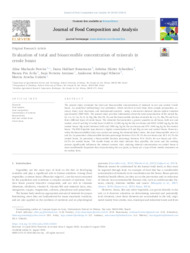Evaluation of total and bioaccessible concentration of minerals in creole beans.
Evaluation of total and bioaccessible concentration of minerals in creole beans.
Author(s): PEREIRA, A. M.; BONEMANN, D. H.; SCHERDIEN, S. H.; ÁVILA, B. P.; ANTUNES, I. F.; RIBEIRO, A. S.; GULARTE, M. A.
Summary: The present study evaluated the total and bioaccessible concentrations of minerals in raw and cooked Creole beans. An analytical methodology was optimized, which involved several steps from sample preparation, accuracy study, data treatment, and instrumental analysis ? using a microwave-induced plasma optical emission spectrometer (MIP OES). The present study provides information about the total concentration of the metals Ba, Cd, Co, Cr, Cu, Fe, K, Li, Mg, Mn, Mo, Pb, Zn and the bioaccessible fraction of metals Ba, Cu, Fe, Mn, Pb and Zn in three different types of creole beans. The elements that presented a greater quantity on all beans, both raw and cooked, were K and Mg. K varied from 12,600 to 13,300 mg/kg for the raw beans and 4590?10300 mg/kg for the cooked beans. Mg varied between 1620 and 1980 mg/kg for the raw beans and 670?1040 mg/kg for the cooked beans. The BRS Expedito type showed a higher concentration of K and Mg on raw and cooked beans. However, when the bioaccessibility study was carried out among the elements listed above, the most bioaccessible were Cu and Zn. Cu presented a bioaccessible fraction percentage between 52.6?59.2% for raw beans and 38.5?61.2% for cooked beans. Zn presented a bioaccessible fraction percentage between 45.6?50.6% for raw beans and 43%?63.5% for cooked beans. The results found on this study indicate that, possibly, the water and the cooking process significantly influences the mineral content. Also, studying mineral concentration on cooked beans is more nutritionally important than characterizing the raw grain, as beans are a type of food mostly consumed on its cooked form.
Publication year: 2020
Types of publication: Journal article
Keywords: Análise de Alimento, Feijão, Feijão crioulo, Grão, Nutriente Mineral
Observation
Some of Embrapa's publications are published as ePub files. To read them, use or download one of the following free software options to your computer or mobile device. Android: Google Play Books; IOS: iBooks; Windows and Linux: Calibre.
Access other publications
Access the Agricultural Research Database (BDPA) to consult Embrapa's full library collection and records.
Visit Embrapa Bookstore to purchase books and other publications sold by Embrapa.

